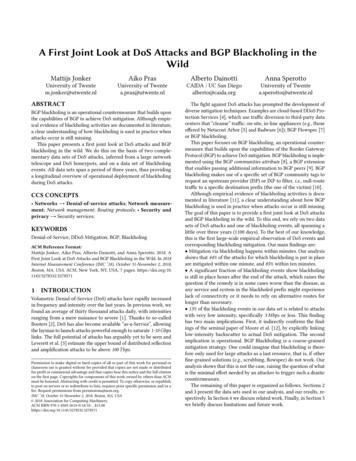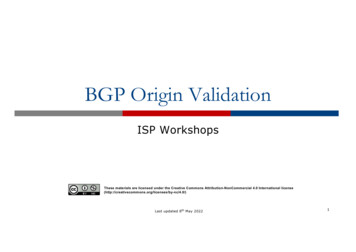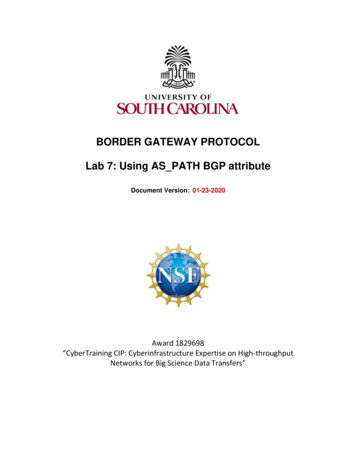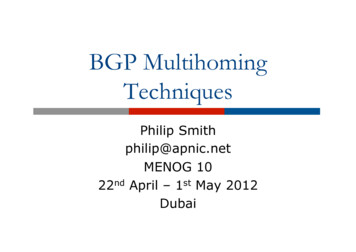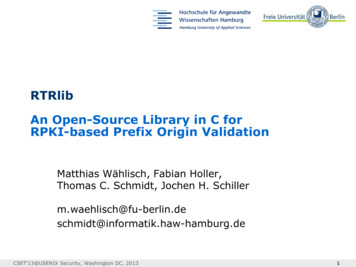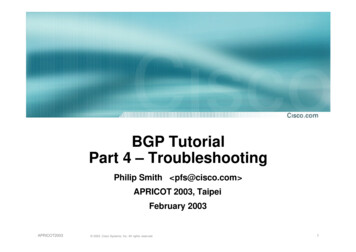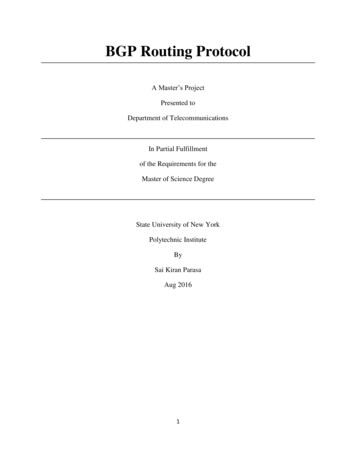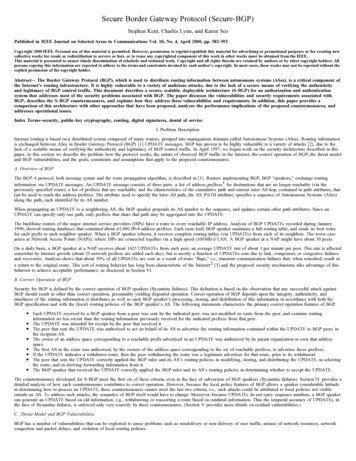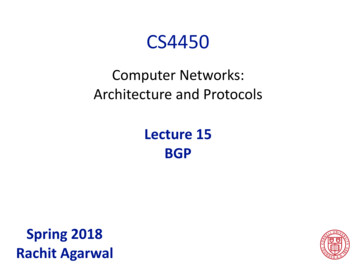
Transcription
CS4450Computer Networks:Architecture and ProtocolsLecture 15BGPSpring 2018Rachit Agarwal
“Autonomous System (AS)” or “Domain”Region of a network under a single administrative entity“Border Routers”“Interior Routers”
Business Relationships Shape Topology and Policy Three basic kinds of relationships between ASes AS A can be AS B’s customerAS A can be AS B’s provider AS A can be AS B’s peerBusiness implications Customer pays provider Peers don’t pay each other Exchange roughly equal traffic
Routing Follows the MoneyPrQAPeerBDEtraffic allowedCFtraffic not allowedCuPeer
Interdomain Routing: Setup Destinations are IP prefixes (12.0.0.0/8) Nodes are Autonomous Systems (ASes) Internals of each AS are hidden Links represent both physical links and business relationships BGP (Border Gateway Protocol) is the Interdomain routing protocol Implemented by AS border routers
BGPAn AS advertisesits best routesto one or more IP prefixesEach AS selects the“best” route it hears advertisedfor a prefixSound familiar?
BGP Inspired by Distance Vector Per-destination route advertisements No global sharing of network topology Iterative and distributed convergence on paths But, four key differences
BGP vs. DV(1) BGP does not pick the shortest path routes! BGP selects route based on policy, not shortest distance/least cost23Node 2 may prefer 2, 3, 1over 2, 11 How do we avoid loops?
BGP vs. DV(2) Path-vector Routing Idea: advertise the entire path Distance vector: send distance metric per dest. dPath vector: send the entire path for each dest. dC“d: path (B,A)”“d: path (A)”ABdata trafficdata trafficd
Loop Detection with Path-Vector Node can easily detect a loop Look for its own node identifier in the pathNode can simply discard paths with loops e.g. node 1 sees itself in the path 3, 2, 13“d: path (2,1)”“d: path (1)”2“d: path (3,2,1)”1d
BGP vs. DV(2) Path-vector Routing Idea: advertise the entire path Distance vector: send distance metric per dest. dPath vector: send the entire path for each dest. dBenefits Loop avoidance is easy Flexible policies based on entire path
BGP vs. DV(3) Selective Route Advertisement For policy reasons, an AS may choose not to advertise a route to adestination As a result, reachability is not guaranteed even if the graph isconnectedAS 1AS 3AS 2Example: AS#2 does notwant to carry trafficbetween AS#1 and AS#3
BGP vs. DV(4) BGP may aggregate routes For scalability, BGP may aggregate routes for different prefixesa.*.*.* is this ella.c.0.0/16
BGP Outline BGP Policy Typical policies and implementation BGP protocol details Issues with BGP
Policy:Imposed in how routes are selected and exportedRoute exportRoute selectionPBQ CSelection: Which path to use AControls whether / how traffic leaves the networkExport: Which path to advertise Controls whether / how traffic enters the networkCan reach128.3/16blah blah
Typical Selection Policy In decreasing order of priority:1. Make or save money (send to customer peer provider)2. Maximize performance (smallest AS path length)3. Minimize use of my network bandwidth (“hot potato”)4.
Typical Export PolicyDestination prefixadvertised by Export route to CustomerEveryone(providers, peers, othercustomers)PeerCustomersProviderCustomersKnown as the “Gao-Rexford” rulesCapture common (but not required!) practice
Gao-RexfordproviderspeerscustomersWith Gao-Rexford, the AS policy graph is aDAG (directed acyclic graph) and routes are “valley free”
BGP Outline BGP Policy Typical policies and implementation BGP protocol details Issues with BGP
Who speaks BGP?Border routerInternal routerBorder routers at an Autonomous System
What Does “speak BGP” Mean? Implement the BGP Protocol Standard Internet Engineering Task Force (IETF) RFC 4271Specifies what messages to exchange with other BGP “speakers” Message types (e.g. route advertisements, updates) Message syntaxSpecifies how to process these messages When you receive a BGP update, do x Follows BGP state machine in the protocol spec and policy decisions,etc.
BGP Sessions“eBGP session”A border router speaks BGP withborder routers in other ASes
BGP Sessions“iBGP session”A border router speaks BGP with other(interior and border) routers in its own AS
eBGP, iBGP, IGP eBGP: BGP sessions between border routers in different ASes iBGP: BGP sessions between border routers and other routerswithin the same AS Learn routes to external destinationsDistribute externally learned routes internallyIGP: Interior Gateway Protocol Intradomain routing protocol Provides internal reachabilitye.g. OSPF, RIP
Putting the Pieces Together623431.2.3.4.91Provide internal reachability (IGP)Learn routes to external destinations (eBGP)Distribute externally learned routes internally (iBGP)Travel shortest path to egress (IGP)2
Basic Messages in BGP Open Notification Establishes BGP sessionBGP uses TCPReport unusual conditionsUpdate Inform neighbor of new routes Inform neighbor of old routes that become inactiveKeepalive Inform neighbor that connection is still viable
Route Updates Format: IP prefix: route attributes Two kinds of updates: Announcements: new routes or changes to existing routes Withdrawals: remove routes that no longer existRoute Attributes Describe routes, used in selection/export decisions Some attributes are local i.e. private within an AS, not included in announcements Some attributes are propagated with eBGP routeannouncements Many standardized attributes in BGP
Route Attributes (1): ASPATH Carried in route announcementsVector that lists all the ASes a route advertisement has traversed(in reverse order)AS 7018AT&TAS 88AS 12654Princeton,128.112/16IP prefix 128.112.0.0/16AS path 88128.112.0.0/16AS path 7018 88
Route Attributes (2): LOCAL PREF “Local Preference”Used to choose between different AS pathsThe higher the value, the more preferredLocal to an AS; carried only in iBGP messages140.20.1.0/24BGP table at AS4:AS1AS3AS2AS4DestinationAS PathLocal Pref140.20.1.0/24AS3 AS1300140.20.1.0/24AS2 AS1100
Route Attributes (3) : MED “Multi-Exit Discriminator”Used when ASes are interconnectedvia two or more linksLink B Specifies how close a prefix is tothe link it is announced on Lower is better AS announcing prefix sets MED AS receiving prefix (optionally!) usesMED to select linkAS1Link AMED 50MED 10AS2AS3destinationprefix
Route Attributes (4): IGP Cost Used for hot-potato routing Each router selects the closest egress point based on the path cost inintra-domain protocoldst9A3DF83485CBE410G
Using Attributes Rules for route selection in priority order1.2.3.4.Make or save money (send to customer peer provider)Maximize performance (smallest AS path length)Minimize use of my network bandwidth (“hot potato”)
Using Attributes Rules for route selection in priority orderPriority RuleRemarks1LOCAL PREFPick highest LOCAL PREF2ASPATHPick shortest ASPATH length3MEDLowest MED preferred4eBGP iBGPDid AS learn route via eBGP(preferred) or iBGP?5iBGP pathLowest IGP cost to next hop(egress router)6Router IDSmallest next-hop router’s IPaddress as tie-breaker
BGP Update ProcessingOpen ended programming.Constrained only by vendor configuration languageControl planeBGPUpdates Apply ImportPoliciesBest RouteSelectionBGPUpdatesBest RouteTableApply ExportPoliciesData planeDatapacketsforwardingEntriesIP Forwarding TableDatapackets
BGP Outline BGP Policy Typical policies and implementation BGP protocol details Issues with BGP
BGP: Issues Reachability Security Convergence Performance Anomalies
Reachability In normal routing, if graph is connected then reachability is assured With policy routing, this doesn’t always holdProviderAS 1AS 3AS 2CustomerProvider
Security An AS can claim to serve a prefix that they actually don’t have aroute to (blackholing traffic) Problem not specific to policy or path vectorImportant because of AS autonomy Fixable: make ASes prove they have a path But AS may forward packets along a route different from what isadvertised Tell customers about a fictitious short path Much harder to fix!
Convergence If all AS policies follow Gao-Rexford rules, Then BGP is guaranteed to converge (safety)For arbitrary policies, BGP may fail to converge!
Example of Policy Oscillation“1” prefers “1 3 0”over “1 0” to reach “0”1301010210202332030
Step-by-step Policy OscillationInitially: nodes 1, 2, 3 know only shortest path to 01301010210202332030
Step-by-step Policy Oscillationadver tise:101 advertises its path 1 0 to 22102013010102332030
Step-by-step Policy Oscillation1301010210202332030
Step-by-step Policy Oscillation3 advertises its path 3 0 to 1130101advertise:302102023032030
Step-by-step Policy Oscillation1301010210202332030
Step-by-step Policy Oscillationwithdraw:101 withdraws its path 1 0 from 22102021301010332030
Step-by-step Policy Oscillation1301010210202332030
Step-by-step Policy Oscillation2 advertises its path 2 0 to 313010102102023advertise: 2 032030
Step-by-step Policy Oscillation1301010210202332030
Step-by-step Policy Oscillation3 withdraws its path 3 0 from 1130101withdraw:302102023032030
Step-by-step Policy Oscillation1301010210202332030
Step-by-step Policy Oscillationadver tise:101 advertises its path 1 0 to 22102013010102332030
Step-by-step Policy Oscillation1301010210202332030
Step-by-step Policy Oscillation2 withdraws its path 2 0 from 313010102102023withdraw: 2 032030
Step-by-step Policy Oscillation1301010210202332030We are back to where we started!
Convergence If all AS policies follow Gao-Rexford rules, Then BGP is guaranteed to converge (safety) For arbitrary policies, BGP may fail to converge! Why should this trouble us?
Performance Non-Issues Internal Routing Policy not about performance Domains typically use “hot potato” routingNot always optimal, but economically expedientSo policy-chosen paths aren’t shortestAS path length can be misleading 20% of paths inflated by at least 5 router hops
Performance (example) AS path length can be misleading An AS may have many router-level hopsBGP says thatpath 4 1 is betterthan path 3 2 1AS 4AS 3AS 2AS 1
Performance: Real IssueSlow Convergence BGP outages are biggest source of Internet problems Labovitz et al. SIGCOMM’97 Labovitz et al. SIGCOMM 2000 10% of routes available less than 95% of the timeLess than 35% of routes available 99.99% of the time40% of path outages take 30 minutes to repairBut most popular paths are very stable
BGP Misconfigurations BGP protocol is both bloated and underspecified Lots of attributesLots of leeway in how to set and interpret attributesNecessary to allow autonomy, diverse policies But also gives operators plenty of rope Much of this configuration is manual and ad hoc And the core abstraction is fundamentally flawed Disjoint per-router configuration to effect AS-wide policyNow strong industry interest in changing this!
BGP: How did we get here? BGP was designed for a different time Before commercial ISPs and their needsBefore address aggregation 1989 : BGP-1 [RFC 1105]Before multi-homing– Replacement for EGP (1984, RFC 904) 1990 : BGP-2 [RFC 1163] 1991 : BGP-3 [RFC 1267] 1995 : BGP-4 [RFC 1771]– Support for Classless Interdomain Routing (CIDR) We don’t get a second chance: ‘clean slate’ designs virtuallyimpossible to deplayThought experiment: how would you design a policy-driveninterdomain routing solution? How would you deploy it?
What Does "speak BGP" Mean? Implement the BGP Protocol Standard Internet Engineering Task Force (IETF) RFC 4271 Specifies what messages to exchange with other BGP "speakers" Message types (e.g. route advertisements, updates) Message syntax Specifies how to process these messages When you receive a BGP update, do x Follows BGP state machine in the protocol spec and policy decisions,
